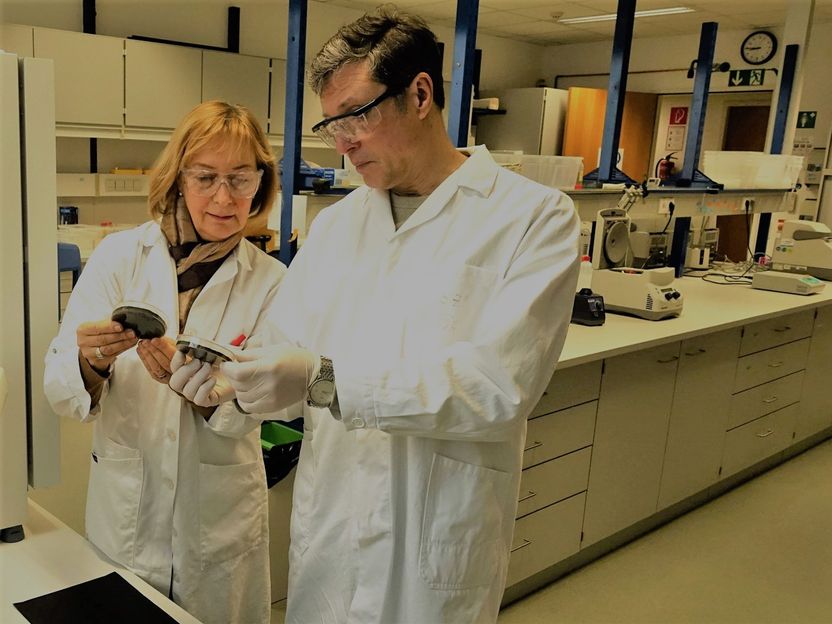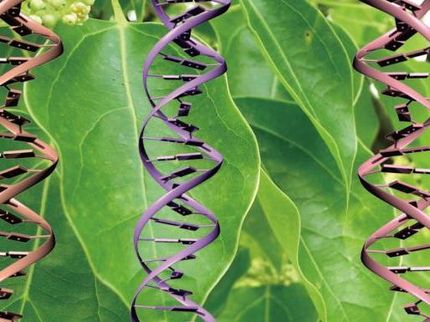How to produce more antibiotics?
Coaxing microorganisms to perform at their best
Advertisement
Producing antibiotics takes a lot of effort – even when the activity is outsourced to bacteria. A Vienna-based research group has now discovered three genes that mimic a state of stress in the cells. With the help of these genes, the researchers intend to coax the microorganisms to stellar performance levels.

Olga Sekurova and Sergey Zotchev in their Vienna lab. The researchers managed to crack a mechanism that steps up the metabolism of bacteria and, thus, their production of antibiotics.
Universität Wien
Antibiotic-resistant infections are a great challenge for hospitals, which is why new antibiotics are urgently needed. Someone who is looking into this situation is Sergey Zotchev of the University of Vienna, a molecular geneticist who heads a laboratory for pharmaceutical biotechnology at the Department of Pharmaceutical Sciences. In his lab, research is underway on as yet undiscovered active substances from nature. In addition, Zotchev is concerned with pragmatic questions. “How do we produce sufficient quantities of these substances?” If nature is left to its own devices, organisms produce just enough to meet their own needs, and this low yield causes problems not only for industrial production: it also prevents the discovery of previously unknown antibiotics. In the “StrepStress” project, Zotchev’s group has now identified three genes that could revolutionize the discovery and production of antibiotics. For this purpose, the researchers used genetic engineering to imitate damaging environmental influences and in this way bred highly productive bacteria.
Production challenges
Originally, the term “antibiotics” simply meant substances that stunt the growth of an organism or kill it (Greek: anti “against”, bios “life”). Antibiotics are produced by fungi, as in the well-known example of penicillin, but also by bacteria and plants – a fact that is utilized by the pharmaceutical industry.
There are, however, certain limitations to this endeavor. “In their natural state, bacteria only produce a few milligrams of antibiotic per liter of cell culture. That is far too little for industrial production, which requires several grams per liter,” notes Zotchev and adds that reaching this target is even more difficult in a laboratory, where natural conditions cannot be fully recreated. Antibiotics usually serve their producers as a defense against competitors or to communicate with neighboring organisms. Since these external factors are absent in the laboratory, the yield is correspondingly low.
A second problem is the long time it takes to grow highly productive bacteria. In the past, this required many consecutive selection steps. Zotchev’s project aims to deliver a shortcut. “If we identify and mutate specific genes from the word go, breeding will take only a month.” For this purpose, the researchers studied the bacterium Streptomyces venezuelae. One of the active substances that this bacterium produces is the antibiotic chloramphenicol. And it presents a special feature. When S. venezuelae is exposed to the alcohol ethanol, it drastically steps up its antibiotic production. This fact has been known since 1994, but until now the workings of this mechanism were unknown. Zotchev’s team has now managed to identify the key genes involved.
And then there were three
“For the first step of our experiments, we collaborated with Thomas Rattei’s research group,” Zotchev reports. Rattei’s group is also based at the University of Vienna and specializes in the computer-assisted analysis of biological systems. “Together, we investigated how ethanol affects the genes.” In S. venezuelae, as in all cells, individual genescan be regulated up or down. This fine-tuning enables the bacterium to respond to the requirements of the respective situation, as for instance when it is exposed to a stressor such as ethanol. “Even we were surprised when we saw that 1246 genes were affected by this environmental stimulus,” says Zotchev. “That accounts for 18 percent of all genes described for S. venezuelae.”
A second step required Zotchev’s team to match all the ethanol-influenced genes with the metabolites that the bacterium produces under these conditions. For this purpose, they collaborated with Martin Zehl from the Center for Mass Spectrometry, also at the University of Vienna. Mass spectrometry enables the researchers to determine the amounts of metabolic products – one of them being antibiotics. The team combined this technique with their previous dataset at the genetic level, which enabled them to determine which of the changes in antibiotic production were associated with which gene regulations. In the end, only three genes were left out of the 1246 that had been affected by ethanol exposure. The mechanism had been successfully cracked.
Sigma factors step on the brakes
“Using the three genes, we produce specialized sigma factors,” Zotchev explains. “Their function is to sense environmental stimuli and turn genes on or off.” It turns out that in the case of antibiotics, these sigma factors have the effect of an engaged handbrake. “They apparently monitor the use of genes that inhibit antibiotic production. As soon as the bacterium perceives a certain environmental stimulus, the membrane communicates that to the inside of the cell,” notes Zotchev. In this way, the sigma factors are down-regulated, which has the effect of turning off the repressor genes. With that, the handbrake is released, the synthesizing process is launched and the bacterium turns into a veritable antibiotics factory.
Back in the lab, the handbrake can be permanently released by artificially removing the genes of the three sigma factors by means of genetic engineering. The researchers used this method to verify their results. They removed the identified genes one by one and were able to observe how antibiotic production skyrocketed. “These were impressive results,” Zotchev reports. “In the case of chloramphenicol, production increased by a factor of 1,700 for one of the sigma factors.”
Has that mechanism been conserved?
Zotchev’s team now wants to investigate whether this effect has also been conserved by evolution in other bacterial species. “We want to confirm that we haven’t just discovered unique genes for this one species of bacterium, but a general mechanism.” If these types of sigma factors also have a regulatory effect on other bacteria, the effect can be used at industrial level and also for scientific discovery. Considerable quantities of active bacterial substances could be produced at low cost. This concerns not only conventional antibiotics already in use. The method could also support the discovery of new antibiotics whose production is inhibited under natural conditions. Ultimately, it could also be used to identify entirely different biologically active natural products, thereby paving the way for the development of novel drugs against cancer and other diseases. All of this by harnessing the hard-working single-cell organisms.




























































